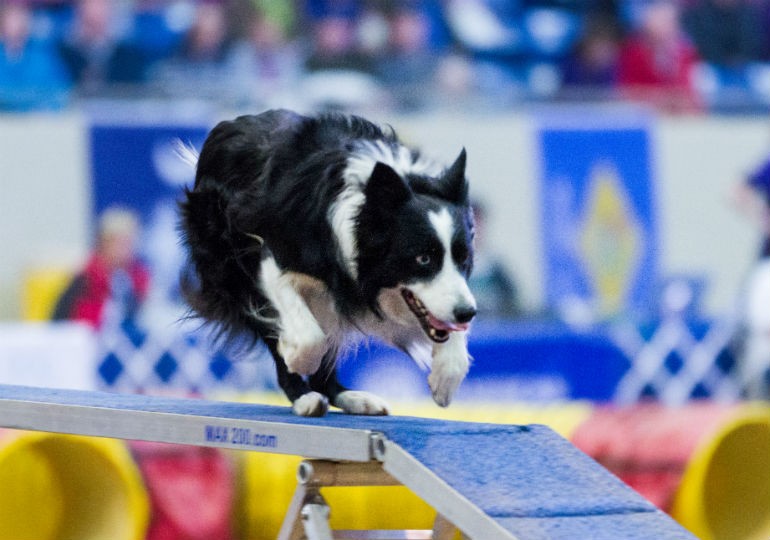Agility is an exciting event that requires conditioning, concentration, training and teamwork. Dog and handlers negotiate an obstacle course racing against the clock, requiring a true bond and very clear communication. We got to witness some fantastic runs at the 2016 AKC National Championship Presented by Royal Canin, and caught up with Carrie DeYoung, Director of Agility, and her daughter, Sally; who gave us some interesting insight on the sport.
AKC: What breeds are you seeing a lot of in the agility ring this weekend?
Carrie DeYoung: It’s done by height, so the 16-inch and the 20-inch particularly, the 20-inch [category] is heavy in Border Collies at a regular weekend, when we move to the invitational there are only five Border Collies here competing, if there’s more than that, that’s because they’re coming from another country. We do invite other countries. Juniors this morning, there was no restriction on how many of what breed. So we’re seeing more of a typical spread like you might see on a given weekend, where you have a lot of Border Collies in the 16- or the 20-inch. You’ve got a lot of Shelties in the 12- and 16-inch. Shelties, Border Collies, Australian Shepherds, Golden Retrievers, those tend to be some of our most popular breeds doing agility. Papillons for the tiny ones. And when we get to tomorrow, and today when we start with our time to beat, there’s only five of each breed here. So you’re not going to see one after another of the same breed.
AKC: Why do you think those breeds do so well in agility?
Carrie DeYoung: Well, physically they’re very agile. They’re built well for an athletic event, they’re bright, they’re breeds that work well as you can see, except for the Golden which is a Sporting breed, they’re Herding breeds, Herding breeds are designed to work directly with their handlers. They’ve got that type of relationship versus terriers, which are very athletic and very smart, but terriers were bred to work independently. And we’ve got some fabulous terriers running this weekend, which is wonderful, because then the public can come over and see a breed that typically they don’t think of them as being able to work well with someone and then they watch them run with their handlers and they’re fabulous.
And then all sorts of other things, but those are our primary small dogs, Fox Terriers; we tend to see some of those, Parson Russell. Parson Russell Terriers are very good at agility and you tend to see a fairly good amount of those out there. So again, it tends to be the breeds though that were bred to work more one-on-one with their person, is what we tend to see.
Sally DeYoung: Like, herding dogs are used to watching their person to see what to do, and if you watch each of the people run, they turn certain ways and they have hand motions that they stick out to their dogs and the dogs are trained to watch their owners, and even when you get into the higher levels, just by the turn of their shoulders or where you’re facing tells your dog where to go. So, a lot of times you’ll see a dog go to a wrong jump, but it’s nothing to do with the dog, it’s just that the owner wasn’t facing that way.
Carrie DeYoung: So, when you’re used to watching, you can see immediately, the tunnel is here but the person starts to go to the next obstacle they rotate their shoulder, they’ve yelled tunnel, but as soon as they rotate their body the dog’s like, “Oh she must have been kidding about that,” because she’s going this way.
We’ve got kids running some pretty quick dogs this weekend but we’ve got dogs here that are running 6-7 yards per second. So when you’ve got a dog going that fast, you don’t have a lot of room for error. Your discussion is pretty quick on everything.
AKC: If you blink, you’ll miss it.
Carrie DeYoung: Yes, very much so.
Sally DeYoung: Border Collies will do this in 20-25 seconds.
Are you thinking about getting involved in the wonderful world of agility? Download the Agility for Beginners e-book below and get answers to frequently asked agility questions here!


